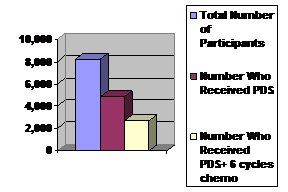Is Medicare Dangerous to Your Patient’s Health? If They Have Ovarian Cancer, Yes
According to government estimates, the incidence of ovarian cancer is almost 13 per 100,000 women per year, and most cases are diagnosed in an advanced stage. As such, proper treatment is critical to ensure survival. However, Dr Melissa M. Thrall, fellow in the department of obstetrics and gynecology at the University of Washington, found that less than 40% of women reliant on Medicare receive standard care.
According to government estimates, the incidence of ovarian cancer is almost 13 per 100,000 women per year, and most cases are diagnosed in an advanced stage. As such, proper treatment is critical to ensure survival. However, Dr Melissa M. Thrall, fellow in the department of obstetrics and gynecology at the University of Washington, found that less than 40% of women reliant on Medicare receive standard care.
Thrall conducted the first large US-population based report on surgery and chemotherapy sequencing for late-stage ovarian disease, looking at the treatment of 8211 women with stage III or stage IV epithelial ovarian cancer over a 10-year period. She will present her findings at the 2011 Annual Meeting on Women’s Cancer, which is presented by the Society of Gynecological Oncologists in Orlando.
Standard treatment for women with such late-stage ovarian cancer is primary debulking surgery (PDS) followed by a minimum of 6 cycles of platinum-based chemotherapy. However, Thrall found that most women did not receive this treatment. In fact, only about 3210 women (39.1%) actually received the standard care. She further found that PDS rates decreased over the course of the study. In 1995, she found that primary surgery was performed in 67.5% of cases but in only 52.8% of cases in 2005. Older women (≥ 80 years of age) and those with stage IV disease were most likely to be treated primarily with chemotherapy instead of receiving standard care.
Additionally, patients who underwent surgery did not always receive the recommended 6 cycles of postoperative chemotherapy. Thrall found that 58% of the women received PDS, but only about half of those patients actually received all 6 cycles of chemotherapy
Figure. Comparison of patients receiving standard treatment.

Although it is unclear why this patient population is not receiving optimum treatment, Thrall did cite several clues from the study that could shed some light on this issue. First, there was no evidence of chemotherapy or surgery for 17% of the patients; these women also had a very short survival (median 2 months). Because these patients were probably very ill, Thrall hypothesized that the women may not have been able to receive treatment. Still, she says, 17% is “too high.” She added that gynecologic oncologists “need to continue to work on educating patients on the symptoms of ovarian cancer and on educating providers on the proper evaluation and referral of these women so they can be offered treatment before they get to this point.” Second, Thrall noticed that some of the data indicated a lack of access to care. For example, the use of chemotherapy as a primary treatment can be associated with factors such as increasing age, stage, and comorbidities, as well as other factors such as race. In this group, primary chemotherapy was used in one quarter (24.6%) of the women, and only 32.2% of these women later had surgery. In addition, marital status and geographic location were associated with inability to complete recommended treatment, which again may signify issues in accessing care. “The study results indicate a need to improve the quality of care delivered to all, but especially the Medicare population, in order to optimize overall patient outcomes and survival rates,” Thrall concluded.
More Information
Related Content
- Ovarian Cancer and the Search for Early Detection
- Scope of Nanotechnology in Ovarian Cancer Therapeutics
Reference
Thrall MM. From guidelines to the front lines: only a minority of the Medicare population with advanced epithelial ovarian cancer receive optimal therapy. Research Brief. SGO. March 2011.
